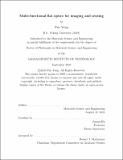| dc.description.abstract | Flat optics refer to optical devices composed of ultra-thin and light-weight planar optical components, which manipulate light in ways that are not possible using conventional bulky optics. Multiple applications including imaging, beam steering, sensing, and projection can be performed through a single layer flat lens, which facilitates the integration between optical and electronic components. Through the arbitrary manipulation of wavefront, flat optics feature improved optical performance and customized functionality.
In this thesis, we focus on the design and optimization of single or multi-layer metasurfaces to construct flat optical components for imaging and sensing applications. We propose a variety of device configurations, analytical analysis, material choices, and prove the effectiveness of the concepts through experimental demonstrations.
We have developed the design concept of wide field-of-view metalens for imaging applications. We proposed the analytical solution to obtain the optimum phase profile of the single layer wide field-of-view metalens, which show diffraction-limited imaging performance with near-180° field-of-view. We further built up the algorithm to design metalens with combined wide field-of-view and achromatic features, which show 1 - 1.2 𝜇𝑚 wavelength broad bandwidth imaging performance with minimal transverse focal shift.
We have demonstrated a variety of depth sensing techniques using metasurfaces. They include passive depth sensing mechanism using stereo camera, and active depth sensing mechanism through structured light projection and beam steering. Near-180° 3-D depth sensing have been realized utilizing the wide field-of-view design concept.
We have further combined multiple optical properties into a single flat optical element through polarization-multiplexing. Based on the proposed concept, we demonstrated another passive 3-D depth sensing mechanism through utilization of metalens with double-helix point-spread-function. The metalens showed meter scale depth sensing range with sub-millimeter accuracy. We have further proposed the design concept of wide field-of-view metalens with extended depth-of-focus. Opposite to metalens for depth sensing, it reveals object information in the entire 3 - 10 𝑚𝑚 extended depth range in the near-180° field-of-view through image deconvolution. We have also proposed a zoom lens with tunable magnification through polarization-multiplexing. An unprecedented 10x zoom ratio between the wide-angle and telephoto mode has been experimentally validated.
Lastly, we have realized the reconfiguration in the mid-infrared band using phase change materials. We demonstrated zoom lens in the 5.2 𝜇𝑚 wavelength leveraging the large refractive index difference of the phase change material 𝐺𝑒₂𝑆𝑒₂𝑆𝑏₄𝑇𝑒₁ between the amorphous and crystalline states. A similar 10x zoom ratio between the two modes has been validated. We have further showed the design concept of a varifocal lens. The focal length can be tuned continuously between 4 - 10 𝑚𝑚 range by controlling the temperature profile of the metasurface. | |
